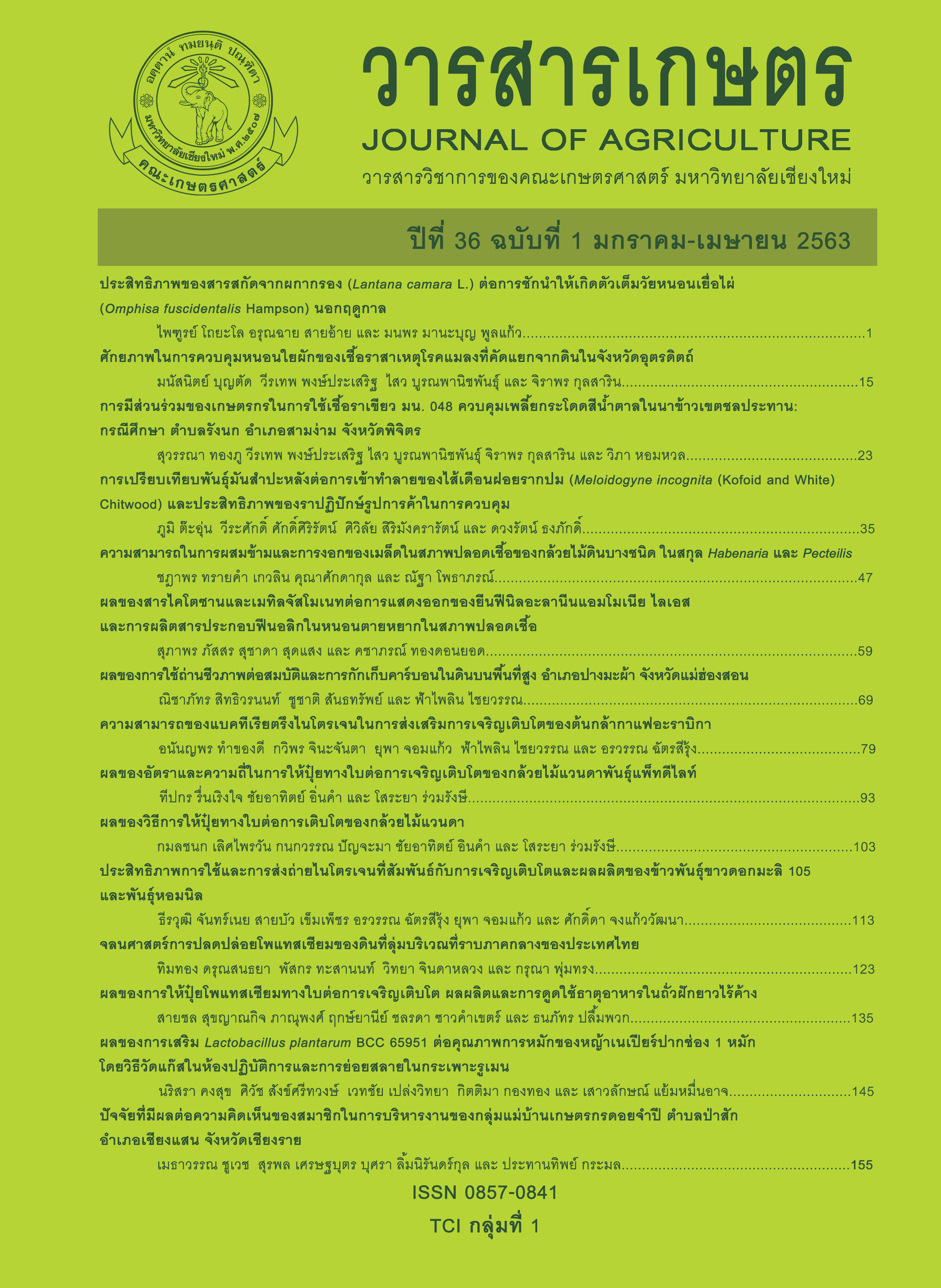ความสามารถของแบคทีเรียตรึงไนโตรเจนในการส่งเสริมการเจริญเติบโตของต้นกล้ากาแฟอะราบิกา
Main Article Content
บทคัดย่อ
ไนโตรเจนเป็นธาตุที่มีความสำคัญมากในการผลิตกาแฟ เนื่องจากเป็นองค์ประกอบของคาเฟอีน การใช้ปุ๋ยเคมีไนโตรเจน บนพื้นที่สูงซึ่งเป็นแหล่งผลิตกาแฟมีความเสี่ยงทำให้เกิดมลพิษต่อสิ่งแวดล้อม การใช้แบคทีเรียตรึงไนโตรเจนจึงเป็นทางเลือกในการลดการใช้ปุ๋ยเคมี การทดลองครั้งนี้จึงได้ทำการแยกแบคทีเรียจากดินรอบรากและเนื้อเยื่อผิวรากกาแฟ จากพื้นที่ปลูกกาแฟ 2 พื้นที่ ได้แบคทีเรียตรึงไนโตรเจน 65 ไอโซเลท คิดเป็น 41.9 % ของไอโซเลททั้งหมด (155 ไอโซเลท) แบคทีเรียตรึงไนโตรเจนที่มีความสามารถทั้งละลายฟอสเฟต และ โพแทสเซียม ได้มีเพียง 23 ไอโซเลท เท่านั้น โดยเชื้อกลุ่มนี้สามารถปลดปล่อยฟอสเฟตจากทั้ง Ca3(PO4)2 และ AIPO4 ได้ 103.58-406.11 และ 8.86-183.82 mg P/L ตามลำดับ ส่วนการละลายโพแทสเซียมมีค่า 23.41-44.67 mg K/L โดยที่ไอโซเลท S2-4a1 มีความสามารถละลายฟอสเฟตจากทั้งสองแหล่งได้สูงที่สุด ในขณะที่ S1-2a4 มีความสามารถละลายโพแทสเซียมได้สูงที่สุด แบคทีเรียตรึงไนโตรเจนทุกไอโซเลทมีความสามารถในการสร้าง Indole 3-acetic acid (IAA) ได้ (0.58-22.80 mg IAA/L) เมื่อคัดเลือกแบคทีเรียที่มีศักยภาพในการละลายฟอสเฟต โพแทสเซียม และการสร้าง IAA ที่ต่างกัน 8 ไอโซเลท มาทดสอบประสิทธิภาพกับต้นกล้ากาแฟพบว่า ไอโซเลท S2-4a1 ให้ค่าการเจริญเติบโตของรากและใบสูง รวมทั้งการดูดใช้ธาตุอาหารสูงกว่า กรรมวิธีควบคุมอย่างมีนัยสำคัญทางสถิติ โดยให้ N, P และ K uptake สูงกว่ากรรมวิธีควบคุม 76, 211 และ 252% ตามลำดับ
Article Details
เอกสารอ้างอิง
Bremner, J.M. 1965. Total nitrogen. pp. 1001-1015. In: R.W. Weaver, J.S. Angle and P.S. Bottomley (eds.). Methods of Soil Analysis. Part 2: Microbiological and Biochemical Properties. Soil Science Society of America, Inc., Madison, Wisconsin.
Delprete, P.G. and J.G. Jardim. 2012. Systematics, taxonomy and floristics of Brazilian Rubiaceae: an overview about the current status and future challenges. Rodriguesia 63(1): 101-128.
Gaur, A.C. 1990. Physiological functions of phosphate solubilizing micro-organisms. pp.16-72. In: A.C. Gaur (ed.). Phosphate Solubilizing Micro-organisms as Biofertilizers. Omega Scientific Publishers, New Delhi.
Gordon, S.A. and R.P. Weber.1951. Colorimetric estimation of indole acetic acid. Plant Physiology 26(1): 192-195.
Hartono, N., F. Asnawati, H. Citra, N.I. Hanhayani, M. Junda, A. Ali, Y. Hala and O. Jumadi. 2016. Ability of ammonium excretion, indol acetic acid production, and phosphate solubilization of nitrogen-fixing bacteria isolated from crop rhizosphere and their effect on plant growth. ARPN Journal of Engineering and Applied Sciences 11(19): 11735-11741.
Hebei Academy of Sciences. 1996. Bio-fertilizer Production. The International Science and Technology Cooperation. The Institute of Microbiology, Hebei. 25 p.
Huangmee, K., T. Punsak, P. Kanghae, W. Homhaul and W. Punsak. 2016. The influence of potassium-solubilizing bacteria to release exchangeable K. pp. 1-7. In: Proceedings of 14th National Conference “Naresuan Research”. Naresuan University, Phitsanulok. (in Thai)
Land Development Department. 2010. Handbook of Soil Chemical Analysis. Document No. OSD-03. Land Development Department, Bangkok. 52 p. (in Thai)
Liu, Z., Y.C. Li, S. Zhang, Y. Fu, X. Fan, J.S. Patel and M. Zhang. 2015. Characterization of phosphate-solubilizing bacteria isolated from calcareous soils. Applied Soil Ecology 96: 217-224.
Panda, B., H. Rahman and J. Panda. 2016. Phosphate solubilizing bacteria from the acidic soils of eastern Himalayan region and their antagonistic effect on fungal pathogens. Rhzosphere 2: 62-71.
Parmar, P. and S.S. Sindhu. 2013. Potassium solubilization by rhizosphere bacteria: Influence of nutritional and environmental conditions. Journal of Microbiology Research 3(1): 25-31.
Suwanwisolkit, P. 2011. Efficiency of arabica coffee production in northern Thailand. Research report. Highland Research and Training Center, Faculty of Agriculture, Chiang Mai University, Chiang Mai. 68 p. (in Thai)
Wang-nai, S. 1985. Soil Microorganism and Activity in Soil. Thai Watana Panich, Bangkok 193 p. (in Thai)
Weaver, R.W. and Seth K.A Danso. 1994. Dinitrogen fixation. pp. 1019-1043. In: R.W. Weaver, J.S. Angle and P.S. Bottomley (eds.). Methods of Soil Analysis. Part 2: Microbiological and Biochemical Properties. Soil Science Society of America, Inc., Madison, Wisconsin.
Wedhastri, S., N.F. Yudianti, J. Widada and J.B. Baon. 2012. Ability of non-symbiotic nitrogen-fixing bacteria isolated from coffee plant rhizosphere and their effects on robusta coffee seedlings. Journal of Agricultural Science and Technology A 2(5): 660-666.
Yiam-on, T., N. Riddech, P. Jaisil and S. Boonlue. 2012. Growth promotion of sugarcane by phosphate solubilizing bacteria in green house condition. Khon Kaen Agricultural Journal 40(Suppl. 3): 185-193. (in Thai)
Yupa, C. 2017. Isolation and characterization of rhizobacteria obtained from arabica coffee. Progress report. PHC SIAM Program 2016-2017. Faculty of Agriculture, Chiang Mai University, Chiang Mai. 10 p.


